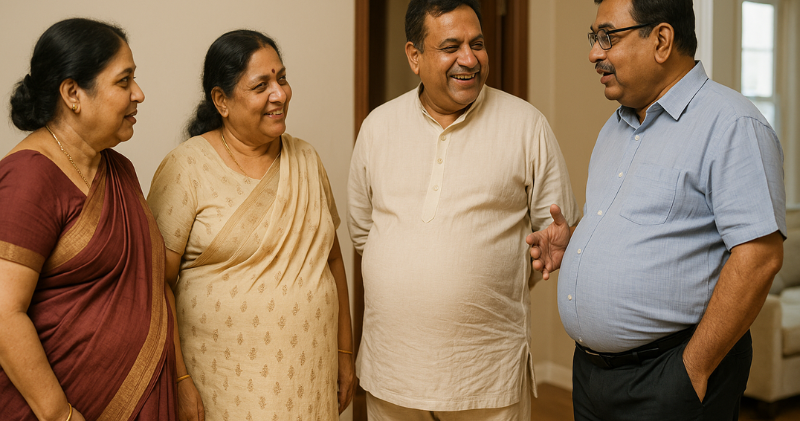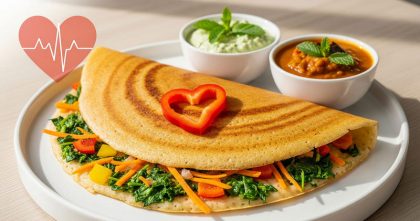Have you noticed how many uncles and aunties in our community have that distinctive round belly? Maybe you’ve noticed your own waistline growing over the years. While we often joke about the “rice belly” or “dal pot,” this extra weight around our middle is actually more serious than just affecting how our clothes fit.
Why Belly Fat Matters More Than Just Looks
Not all fat in our body is the same. The fat that collects around our stomach area—especially deep inside around our organs—is called visceral fat. This type of fat is not just sitting there quietly. It actively produces harmful substances that can damage our health.
Think of visceral fat like an unwanted factory inside your body that creates chemicals that can:
- Increase inflammation throughout your body
- Raise your blood sugar levels
- Make your blood pressure go up
- Increase your risk for heart attacks and stroke
For South Asians, this is especially important because our bodies tend to store more of this dangerous belly fat than other groups—even when we look slim or have a “normal” weight on the scale. This helps explain why heart disease and diabetes are so common in our community, even among people who don’t appear overweight.
Common Indian Food Habits That Add to Belly Fat
Many of our traditional eating patterns worked well when our grandparents were farmers or had more active jobs. But today, these same food habits can lead to belly fat when combined with our less active lifestyles:
Rice and More Rice
Many Indian families eat large portions of white rice 2-3 times daily. White rice is quickly converted to sugar in our body, which can increase fat storage, especially around the middle.
Double Carbohydrates
We often combine multiple carbs in the same meal—like rice with potatoes in biryani, or roti with rice. This carb overload gives our body more sugar than it needs.
Snack Time Troubles
Between meals, many of us enjoy fried snacks like samosas, pakoras, or mixture with our chai. These provide a lot of calories from unhealthy fats and refined flour.
Sweet Additions
Multiple cups of chai with sugar throughout the day, plus mithai (sweets) on regular occasions add hidden calories that convert to belly fat over time.
Missing Protein and Vegetables
Many traditional meals focus mainly on rice or roti with a small amount of curry or dal. Without enough protein and vegetables, these meals can spike blood sugar and promote fat storage.
Why Our Culture Sometimes Hides the Risk
Several cultural factors can prevent us from noticing belly fat problems:
Body Perception
In many South Asian families, having a little belly is sometimes seen as a sign of prosperity or comfort rather than a health concern. “Looking healthy” often means carrying some extra weight.
Clothing Choices
Traditional clothing like sarees, kurtas, and loose-fitting pants can hide weight gain, sometimes for years. Many people don’t realize how much belly fat they’ve gained until they try Western clothing or have a medical checkup.
The Vegetarian Assumption
Many vegetarian South Asians assume their diet is automatically healthy. While vegetarian eating can be very healthy, many Indian vegetarian diets are high in refined carbs, oils, and sweets while being low in protein—a combination that can increase belly fat.
Simple Food Swaps That Respect Our Traditions
The good news is that we don’t need to give up our beloved foods completely. Small changes can make a big difference:
Rice Modifications
- Mix white rice 50-50 with brown rice or millets like ragi
- Reduce your portion to 1/4 of your plate instead of 1/2
- Try cauliflower rice once or twice a week
- Have rice at one meal instead of multiple daily meals
Add Protein to Every Meal
- Include more dal, yogurt, paneer, eggs, or fish
- Try adding sprouted moong or chana to meals
- Add tofu to curries (it takes on the flavor of your spices)
- Eat protein first before starting on the rice or roti
Smarter Snacking
- Replace fried snacks with roasted chana, peanuts, or makhana (fox nuts)
- Keep cut vegetables ready for quick snacking
- Try fruit with a small amount of nut butter
- Make dhokla or idli instead of fried snacks
Mindful Cooking and Eating
- Measure oil with a spoon instead of pouring freely
- Use smaller plates to naturally reduce portions
- Eat sitting down, slowly, without distractions
- Serve vegetables first, then protein, and carbs last
Making Changes Without Feeling Bad
Changing food habits that connect us to our culture and family can feel difficult. Remember these points:
- Start small: Even reducing rice portions by 25% or adding one more vegetable to your plate is progress
- Focus on adding, not just taking away: Add more vegetables, protein, and healthy fats before cutting favorite foods
- Involve family: When everyone makes changes together, it becomes the new normal
- Keep the flavors you love: Our wonderful spices and cooking techniques can make healthier foods taste delicious
The Heart of the Matter
Indian food is not the enemy—it’s part of our identity and brings joy to our lives. The key is how we adapt our traditional eating patterns to match our modern, less active lifestyles.
Even small adjustments—like slightly smaller portions, better food combinations, and more mindful eating—can help reduce dangerous belly fat while still honoring our cultural food traditions.
Remember, the goal isn’t a perfect diet but a healthier relationship with our beloved foods that keeps both our cultural connections and our hearts strong for years to come.




